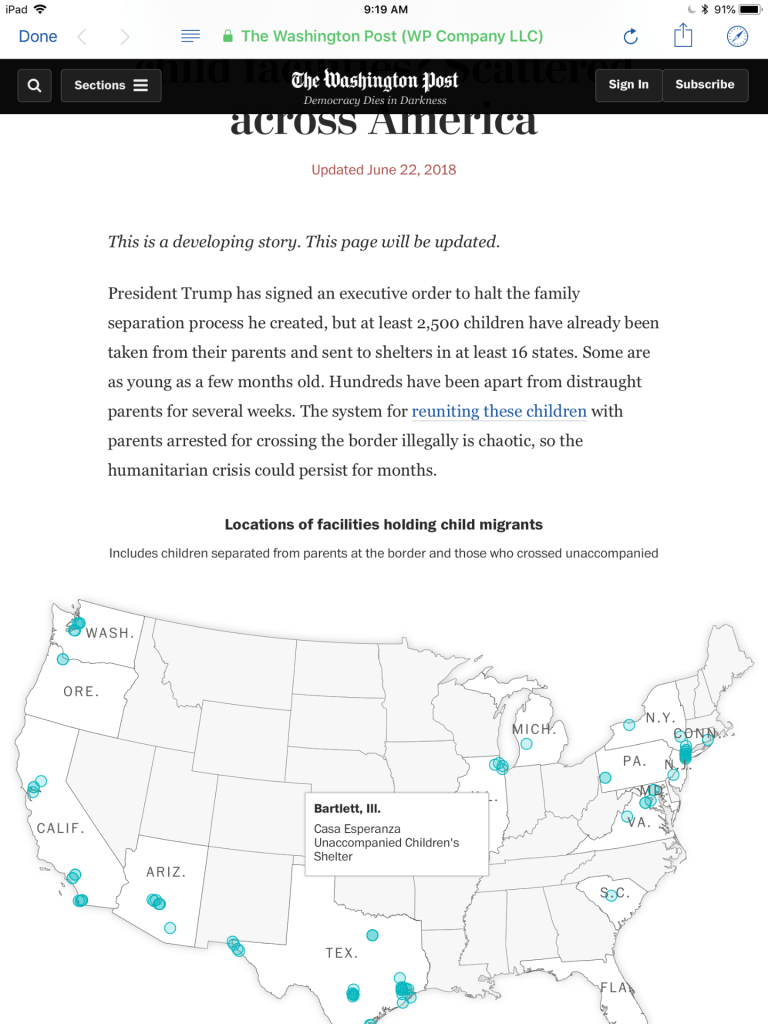I wrote this text as a discussion forum posting for my ENGL 184: Intro to Literature Students on Jun 25, 2018 12:41 PM. We were reading literature about journeys, and I wanted them to post at the beginning of the semester a discussion posting introducing themselves to their “class colleague” and “tell[ing] us about a personal journey—a physical journey or a psychological journey—in which …[they] learned something significant.” I wrote this to introduce myself to them and also to give them an example of the sort of journey that they might write about themselves. I’m posting this in my blog as a quick reminder to folks about the importance of images in blog postings (and it’s something I could grab quickly from D2L and modify into a blog posting. 😉 )
I’ve taken lots of journeys in my life—both physical and psychological journeys—and I’ve learned from each of them. I’ve been thinking frequently about one such psychological journey since news broke this summer of the separation of immigrant families and their detention at camps.
 I went home and asked my dad if he knew anything about this. He responded by going to get a book he owned that I’d never seen — When I was a freshman in high school, I needed to write a research paper and couldn’t come up with a topic. My history teacher suggested that I write about the Nisei or about the Japanese internment camps.I went home and asked my dad if he knew anything about this. He responded by going to get a book he owned that I’d never seen — Yankee Samurai: The Secret Role of Nisei in America’s Pacific Victory — and showing me a picture of his best friend, Jerry (Jiro) Katayama, who was a decorated Nisei who served in Military Intelligence in Leyte (an island in the Phillipines) and Okinawa during World War II while his family was incarcerated in a Japanese internment camp in California. His family lost everything.
I went home and asked my dad if he knew anything about this. He responded by going to get a book he owned that I’d never seen — When I was a freshman in high school, I needed to write a research paper and couldn’t come up with a topic. My history teacher suggested that I write about the Nisei or about the Japanese internment camps.I went home and asked my dad if he knew anything about this. He responded by going to get a book he owned that I’d never seen — Yankee Samurai: The Secret Role of Nisei in America’s Pacific Victory — and showing me a picture of his best friend, Jerry (Jiro) Katayama, who was a decorated Nisei who served in Military Intelligence in Leyte (an island in the Phillipines) and Okinawa during World War II while his family was incarcerated in a Japanese internment camp in California. His family lost everything.
I knew Jerry really well: he played golf with my dad, ate dinner at our house often, and fell asleep on the couch watching TV with my dad. And I didn’t know anything about this aspect of his personal history or about the internment camps. It wasn’t in any of the history books. And although I don’t remember much about writing my paper, I remember that I was really angry when I wrote the paper and for some time after—not only angry that this had happened, and in our country, but also that our history books didn’t talk at all about this. This is the first time I realized that history could be selective and that our country did things that were, to put it politely, wrong.
I do remember talking to my dad at that time about Jerry’s personal and military history. My dad was really proud of Jerry, who had given him the book and had, as a good friend, talked a lot about his experience. (My brother Bob also talked with Jerry about it after he finished his military service.). But I didn’t talk to Jerry: I was young and felt it was too private.
I do have a copy of the book with Jerry’s picture and have also found that Jerry (Jiro) is included in the Japanese American Service Committee (now JASC)’s Legacy Center Archives, where I found this picture and other images and documents about Jerry:
The group, located in Chicago, helped with resettling Japanese Americans after the war and has continued to preserve historical material from the Japanese American community in the area, making it available for research and educational activities. They also seek “to preserve and promote community heritage and common understanding of the Japanese American experience as an integral part of American history.”
Other groups and individuals clearly do this too. George Takai talks a lot (on Twitter) about his family’s experience incarcerated in a camp; he’s written a graphic novel for children about it too. Also, he’s responded frequently to current government actions on immigration. Not everyone is so forthcoming. Roy Saigo, who was SCSU president from 2000-2007, wouldn’t talk about being incarcerated as a Japanese American when he was very young (5 or so). In fact, when I heard about this background, I was going to ask him about it and tell him about Jerry and was advised by several people in Administration not to do either.
I apologize for writing such a long posting. But today (June 25, 2018) I saw a map of relocation centers housing the immigrant children taken from their parents, and one of them is in Bartlett, IL, where my brother Jim lives.
My brother tells me that Casa Esperanza has “worked in Chicago since 1994 with people who need temporary housing” and wonders “how many kids [they’re housing] and if they have the staff and language skills needed.” My sister, noticing the number of shelters in and around Chicago—currently six—says “that is horrifying.” I have to agree.



